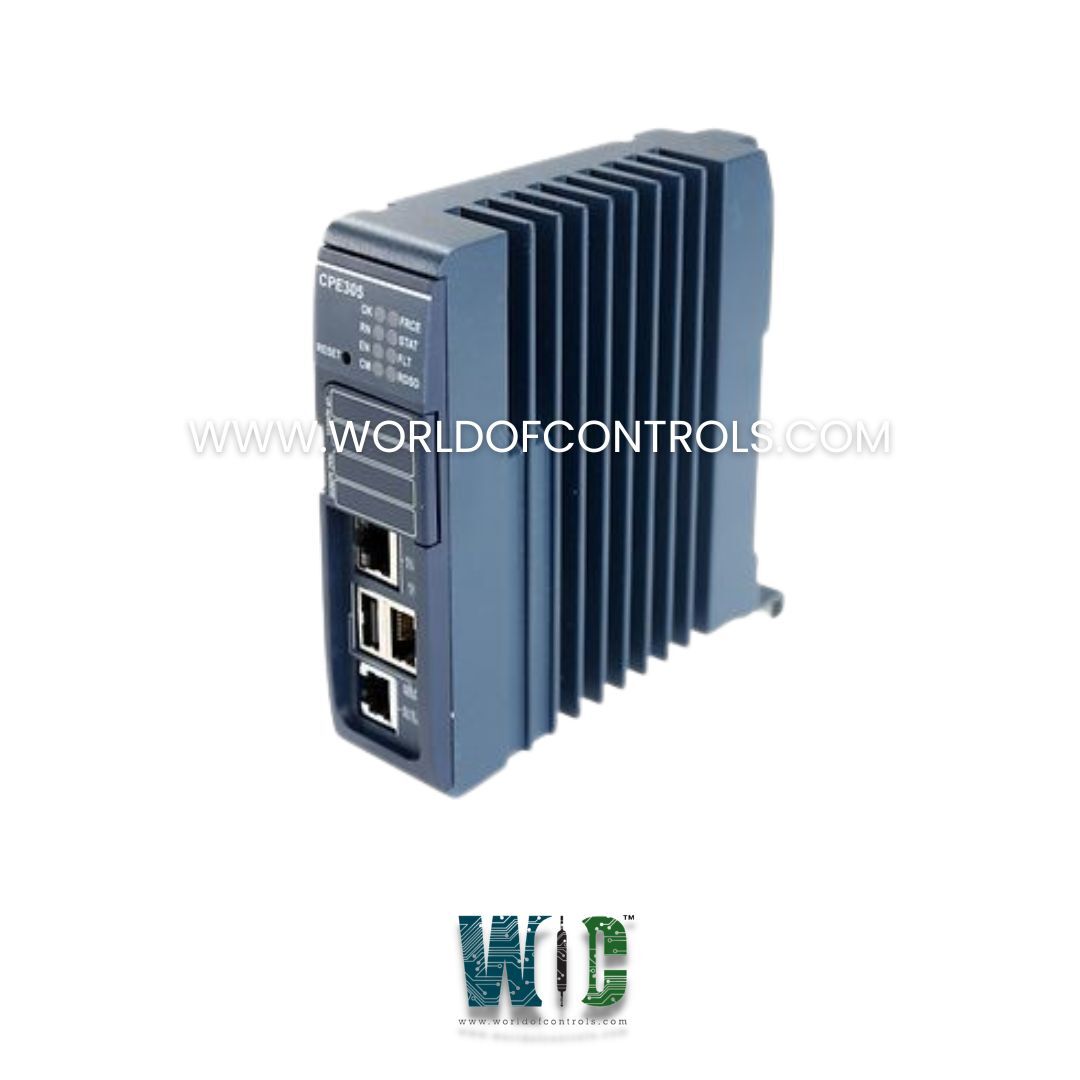
World Of Controls understands the criticality of your requirement and works towards reducing the lead time as much as possible.
IC695CPE305 - RX3i Central Processing Module is available in stock which ships the same day.
IC695CPE305 - RX3i Central Processing Module comes in UNUSED as well as REBUILT condition.
To avail our best deals for IC695CPE305 - RX3i Central Processing Module, contact us and we will get back to you within 24 hours.
SPECIFICATIONS:
Part No: IC695CPE305
Manufacturer: General Electric Fanuc
Product Type: CPU module
Product Line: RX3i PacSystem
Weight: 1.00 lbs
Compatibility: PACSystems RX3i
Clock Speed: 1.1 GHz
RAM: 5MB
NVRAM: 10MB
Switchover time: Maximum 1 logic scan
Serial Ports: 2
Communication standards: RS232
Maximum Program Blocks: 512
Maximum Block Size: 128 kilobytes
Processor Speed: 1.1G Hertz
Serial Communication: RS-232
Program Storage: 5 MB
Protocol Support: Modbus RTU Slave
Backplane: Universal backplane
Size: 8.83 x 3.58 x 4.7 inches
Product Lifecycle: Discontinued By Manufacturer
Availability: In Stock
Country of Origin: USA
FUNCTIONAL DESCRIPTION:
IC695CPE305 is an RX3i Central Processing Module manufactured and designed by General Electric as part of the Mark II Series used in GE Speedtronic Control Systems. The PACSystems� RX3i CPE305 can be used to perform real-time control of machines, processes, and material handling systems. The CPU communicates with the programmer via the internal Ethernet port or a serial port. It communicates with I/O and Intelligent Option modules over a dual PCI/Serial backplane.
REAL TIME CLOCK BATTERY:
This controller is equipped with a single Ethernet port supporting 10/100 Mbps, providing reliable and high-speed network connectivity. It facilitates communication with programming workstations, Human Machine Interfaces (HMI), Supervisory Control and Data Acquisition (SCADA) systems, third-party hardware and software, and other controllers within the same platform for messaging and inter-controller data exchange. In addition, the Ethernet port supports the OPC UA standard, enabling seamless and secure integration with third-party devices and software applications via the OPC protocol. This capability ensures flexible network architecture, efficient data sharing, and streamlined system interoperability in industrial automation environments.
ETHERNET PORT:
The embedded Ethernet interface on the CPE305 CPU enables seamless communication with the Machine Edition programming software using the proprietary SRTP (Service Request Transport Protocol). It supports up to two SRTP server connections, allowing multiple programming or monitoring sessions simultaneously. The interface features a single RJ-45 Ethernet port with automatic detection of link parameters, including data rate (10 Mbps or 100 Mbps), duplex mode (half or full duplex), and cabling type (straight-through or crossover). This auto-sensing capability ensures reliable connectivity and simplifies network setup, making integration with programming workstations, HMIs, SCADA systems, and other networked devices both efficient and straightforward.
HARDWARE INSTALLATION:
The IC695CPE305 RX3i Central Processing Unit (CPU) is a single-slot controller that supports up to eight local racks and complies with PCI 2.2 electrical standards. It is compatible with a universal backplane, RX3i Series PCI devices, and GE Series 90-30 style serial devices. The module requires 1 A at 5 V DC, 1 A at 3.3 V DC, and 0.5 A at 24 V DC, and supports multiple serial protocols, including SNP Slave, Serial I/O, and Modbus RTU Slave.
The embedded Ethernet interface provides 10/100 Mbps connectivity via a 10Base-T RJ-45 port and supports remote monitoring over UDP. The CPU can be installed in any pair of RX3i main rack slots, except for the highest-numbered slots, and is backward compatible with CPE310 controllers to retain existing user programs. Configuration and programming are performed using Proficy Machine Edition Logic Developer 7.0 SIM 3 or later, enabling efficient logic development, diagnostics, and system integration.
WOC maintains the largest inventory of OEM replacement parts for GE Speedtronic Turbine Control Systems, ensuring that your operations remain uninterrupted. In addition to supplying new and unused parts, we also offer expertly rebuilt and refurbished boards, each backed by a comprehensive warranty for your peace of mind. Our highly trained team of automation specialists is available 24/7 to provide technical support, assist with troubleshooting, and help you identify the exact parts or solutions you need for your turbine control systems. Whether you require emergency repairs, routine maintenance, or assistance with system upgrades, WOC is committed to delivering reliable, high-quality service tailored to your operational requirements. For pricing, availability, or consultation on parts and repair services, please contact our team directly by phone or email, and we will ensure prompt and professional support.
What is the IC695CPE305 RX3i CPU?
The IC695CPE305 is a single-slot central processing unit designed for the RX3i system, capable of supporting up to eight local racks. It provides high-performance control and communication for industrial automation applications.
Which hardware devices are supported?
The CPU is compatible with RX3i Series PCI modules, universal backplanes, and GE Series 90-30 style serial I/O devices. This ensures seamless integration with both modern and legacy hardware, allowing flexible system expansion and interoperability across different automation components.
What are the power requirements?
The module requires 1 A at 5 V DC, 1 A at 3.3 V DC, and 0.5 A at 24 V DC. It is designed to operate within standard industrial temperature and humidity ranges, with built-in protection circuitry to safeguard against power fluctuations and ensure stable operation.